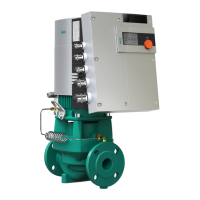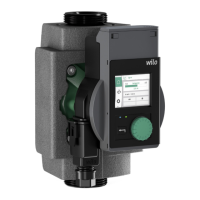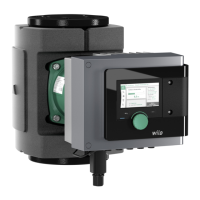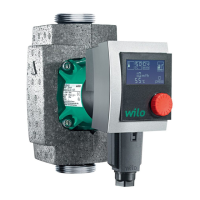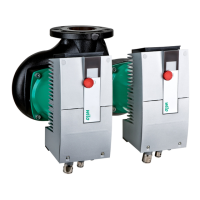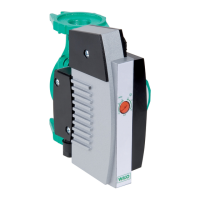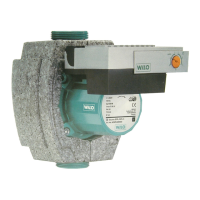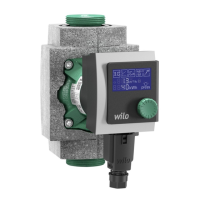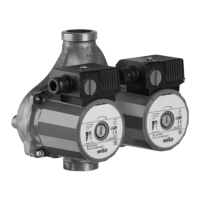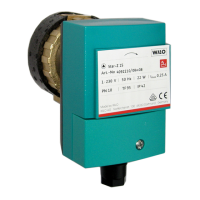Do you have a question about the Wilo Stratos and is the answer not in the manual?
Explains the purpose and scope of the installation and operating instructions.
Details safety symbols and signal words like DANGER, WARNING, CAUTION, and NOTE.
Specifies the required qualifications for personnel performing installation and work.
Outlines potential risks and consequences of not following safety instructions.
Emphasizes compliance with safety instructions and regulations.
Provides safety measures for operators regarding appliance use and hazardous materials.
Details safety measures for inspection and installation work.
Warns against unauthorized modifications and stresses the use of original spare parts.
States that operational safety is guaranteed only if used as intended and within specified limits.
Warns about incorrect transport and storage causing damage and injury.
States the pump is intended for specific fluids and warns against others.
Warns about specific fluids posing health hazards and not being suitable for certain applications.
Details requirements for permissible liquids and additives.
Explains the coding system for product types and configurations.
Lists technical specifications like power supply, frequency, temperature, etc.
Provides a table of minimum inlet pressures at different liquid temperatures.
Lists the components included in the product package and available accessories.
Describes the pump's design and installation types (single-head, twin-head).
Explains how the pump operates, including control modules and differential pressure.
Highlights advantages of the electronic control system.
Details the available operating modes like 'Heating' and 'Cooling/air-conditioning'.
Explains different differential pressure control systems like Δp-v, Δp-c, Δp-T.
Describes speed regulation modes like constant speed and night setback.
Covers overload protection, data storage, and pump restart behavior.
Explains operation for twin-head pumps, including master/slave and optimization modes.
Explains the meaning of symbols shown on the pump's LC display.
Warns about dangers from electrical energy and requirement for qualified electricians.
Warns about potential bodily injury and adherence to accident prevention regulations.
Details risks of injury and property damage during installation.
Warns about potential property damage due to incorrect installation, welding, or foreign material.
Provides guidance on insulating pumps for specific system types.
Warns about property damage from incorrect electrical connections or voltage.
Advises on cable requirements, fuse protection, and grounding.
Details electrical connection methods for single and double pumps.
Directs users to relevant safety and operation chapters before commissioning.
Warns against operating the pump dry and emphasizes proper filling.
Warns about hot surfaces and the risk of burns when setting the menu.
Explains how to use the control button for basic settings and navigation.
Describes how to change the display orientation (horizontal/vertical).
Details menu settings for single pump mode.
Continues explaining menu settings, including position and control mode selection.
Details menu settings for IF Modules with 0-10V input.
Explains settings for switching pumps on/off and enabling/disabling setback operation.
Guides on initial setup for double pump modes (Master/Slave).
Explains menu navigation for double pump modes during operation.
Details how to configure the bus address for communication.
Explains how to configure IF Modules like baud rate and bit format.
Guides on selecting operating modes for Heating/Ventilation and Refrigeration/Air-conditioning.
Continues explaining operating mode selection for HV/AC.
Lists common faults, their causes, and remedies for external fault sources.
Details fault signals specific to HV operating mode.
Details fault signals specific to AC operating mode.
Lists fault signals, causes, and remedies in a table.
Lists warning messages, their causes, and remedies.
Presents a table of warning messages, causes, and remedies.
Discusses operational issues related to electromagnetic fields and device malfunctions.
Warns about electric shock risks during decommissioning.
Warns about the risk of burns from hot pump surfaces during decommissioning.
Outlines requirements for maintenance and service by authorized representatives.
Warns about risks of injury and damage during dismantling/installation.
Alerts to dangers from strong magnetic fields during dismantling.
Warns about fatal electrical shock risks when dealing with modules.
Warns about property damage when removing or installing the motor head.
Warns about incorrect dismantling/installation causing damage to the control module.
Explains the purpose and scope of the installation and operating instructions.
Details safety symbols and signal words like DANGER, WARNING, CAUTION, and NOTE.
Specifies the required qualifications for personnel performing installation and work.
Outlines potential risks and consequences of not following safety instructions.
Emphasizes compliance with safety instructions and regulations.
Provides safety measures for operators regarding appliance use and hazardous materials.
Details safety measures for inspection and installation work.
Warns against unauthorized modifications and stresses the use of original spare parts.
States that operational safety is guaranteed only if used as intended and within specified limits.
Warns about incorrect transport and storage causing damage and injury.
States the pump is intended for specific fluids and warns against others.
Warns about specific fluids posing health hazards and not being suitable for certain applications.
Details requirements for permissible liquids and additives.
Explains the coding system for product types and configurations.
Lists technical specifications like power supply, frequency, temperature, etc.
Provides a table of minimum inlet pressures at different liquid temperatures.
Lists the components included in the product package and available accessories.
Describes the pump's design and installation types (single-head, twin-head).
Explains how the pump operates, including control modules and differential pressure.
Highlights advantages of the electronic control system.
Details the available operating modes like 'Heating' and 'Cooling/air-conditioning'.
Explains different differential pressure control systems like Δp-v, Δp-c, Δp-T.
Describes speed regulation modes like constant speed and night setback.
Covers overload protection, data storage, and pump restart behavior.
Explains operation for twin-head pumps, including master/slave and optimization modes.
Explains the meaning of symbols shown on the pump's LC display.
Warns about dangers from electrical energy and requirement for qualified electricians.
Warns about potential bodily injury and adherence to accident prevention regulations.
Details risks of injury and property damage during installation.
Warns about potential property damage due to incorrect installation, welding, or foreign material.
Provides guidance on insulating pumps for specific system types.
Warns about property damage from incorrect electrical connections or voltage.
Advises on cable requirements, fuse protection, and grounding.
Details electrical connection methods for single and double pumps.
Directs users to relevant safety and operation chapters before commissioning.
Warns against operating the pump dry and emphasizes proper filling.
Warns about hot surfaces and the risk of burns when setting the menu.
Explains how to use the control button for basic settings and navigation.
Describes how to change the display orientation (horizontal/vertical).
Details menu settings for single pump mode.
Continues explaining menu settings, including position and control mode selection.
Details menu settings for IF Modules with 0-10V input.
Explains settings for switching pumps on/off and enabling/disabling setback operation.
Guides on initial setup for double pump modes (Master/Slave).
Explains menu navigation for double pump modes during operation.
Details how to configure the bus address for communication.
Explains how to configure IF Modules like baud rate and bit format.
Guides on selecting operating modes for Heating/Ventilation and Refrigeration/Air-conditioning.
Continues explaining operating mode selection for HV/AC.
Lists common faults, their causes, and remedies for external fault sources.
Details fault signals specific to HV operating mode.
Details fault signals specific to AC operating mode.
Lists fault signals, causes, and remedies in a table.
Lists warning messages, their causes, and remedies.
Presents a table of warning messages, causes, and remedies.
Discusses operational issues related to electromagnetic fields and device malfunctions.
Warns about electric shock risks during decommissioning.
Warns about the risk of burns from hot pump surfaces during decommissioning.
Outlines requirements for maintenance and service by authorized representatives.
Warns about risks of injury and damage during dismantling/installation.
Alerts to dangers from strong magnetic fields during dismantling.
Warns about fatal electrical shock risks when dealing with modules.
Warns about property damage when removing or installing the motor head.
Warns about incorrect dismantling/installation causing damage to the control module.
| Shaft Material | Stainless steel |
|---|---|
| Application | Heating |
| Power Supply | 1~230 V, 50/60 Hz |
| Motor Efficiency | High efficiency |
| Control | Electronic speed control, differential pressure control |
| Operating Mode | constant speed (n-constant) |
| Motor Protection | Thermal overload protection |
| Pump Housing Material | Cast iron or stainless steel |
| Impeller Material | composite material |
| Bearing Material | Ceramic |
| Fluid Temperature | -10 °C to +110 °C (depending on model) |
| Maximum Operating Pressure | 10 bar |
| EEI | ≤ 0.20 |
| Material | Cast iron, stainless steel, composite materials |
| Energy Efficiency Class | Not applicable (EEI rating is used instead) |
